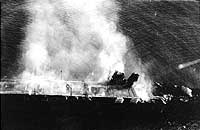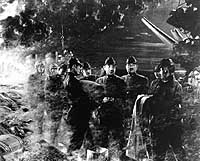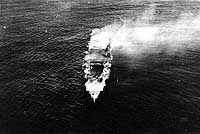
With three of their four carriers blazing furiously by 1030 on 4 June, Hiryu, steaming ahead of the others, was the sole remaining Japanese hope. She responded aggressively, launching a strike force of eighteen dive bombers at about 1100 and a second force of ten torpedo planes some two-and-a-half hours later. The bombers hit USS Yorktown at about noon, temporarily stopping her. The other planes executed a successful torpedo attack on the same ship at about 1445, putting her completely out of action. Though most of the Japanese planes were lost, enough got back to allow Hiryu to prepare a third strike.
Just before Hiryu's bombers came in, Yorktown launched a group of ten SBDs to search for the Japanese carrier, which Rear Admiral Frank Jack Fletcher suspected had survived the morning attack. Two planes, piloted by Lieutenants Samuel Adams and Harlan R. Dickson, spotted Hiryu at about the same time that her torpedo planes hit Yorktown. By about 1600, Rear Admiral Raymond A. Spruance's carriers Enterprise and Hornet had forty SBDs in the air. These found their target shortly before 1700, just as Hiryu was ready to launch her third attack with five bombers and four torpedo planes, all she had left.
The Enterprise planes (including ten refugees from Yorktown) put at least four bombs into the Japanese carrier, destroying her forward flight deck and setting her afire. Later, several Army B-17s attacked, hitting her only with machine gun bullets.
Hiryu, though incapable of offensive action, kept moving until about midnight, when flames and explosions finally stopped her engines. She was ordered abandoned and then torpedoed to hasten sinking, but remained afloat until about 0900 on 5 June. Soon after daybreak, a plane from the small carrier Hosho, accompanying Admiral Yamamoto's approaching battleship force, found the drifting ship, photographed her and reported that there were still men on board. The destroyer Tanikaze was sent to investigate, but found nothing. Later in the day, this destroyer was attacked by over fifty U.S. carrier planes and, in a notable feat of shiphandling, escaped. Further to the west, the rest of the once-invincible Japanese fleet was in full retreat.
This page features views related to the loss of the Japanese aircraft carrier Hiryu.
For other related pictures, see:
For links to pictures concerning the other attacks on the
Japanese carriers, see:
For links to views of other aspects of the Battle of Midway,
see:
| If you want higher resolution reproductions than the Online Library's digital images, see: "How to Obtain Photographic Reproductions." |
Click on the small photograph to prompt a larger view of the same image.
|
Photo #: 80-G-701885 Battle of Midway, June 1942 Diorama by Norman Bel Geddes, depicting attacks by U.S. Navy carrier dive bombers on the Japanese aircraft carrier Hiryu during the afternoon of 4 June 1942. The diorama also shows some of Hiryu's accompanying ships under bombing attack. Official U.S. Navy Photograph, now in the collections of the National Archives. Online Image: 118KB; 740 x 605 pixels Reproductions of this image may also be available through the National Archives photographic reproduction system. |
 |
|
Photo #: 80-G-7746 Battle of Midway, June 1942 Aviation Ordnanceman Second Class Clifton R. Bassett, of Bombing Squadron Three (VB-3), is carried down the flight deck of USS Enterprise (CV-6), 4 June 1942. He was wounded by Japanese aircraft gunfire while VB-3 was attacking Hiryu. Bassett was radioman/gunner of the SBD "Dauntless" scout-bomber flown by Ensign Bunyan R. Cooner, USNR, seen here walking to the right of the stretcher party. Photographed looking forward from the carrier's island. Note flight deck distance markings and aircraft tie-down strips. Official U.S. Navy Photograph, now in the collections of the U.S. National Archives. Online Image: 154KB; 740 x 600 pixels Reproductions of this image may also be available through the National Archives photographic reproduction system. |
 |
|
Photo #: 80-G-7745 Battle of Midway, June 1942 Aviation Ordnanceman Second Class Clifton R. Bassett, of Bombing Squadron Three (VB-3), is carried from the flight deck of USS Enterprise (CV-6), 4 June 1942. He had been wounded by Japanese aircraft while VB-3 was attacking Hiryu. Bassett was radioman/gunner of the SBD "Dauntless" scout-bomber flown by Ensign Bunyan R. Cooner, USNR, seen here at top center wearing an inflatable life jacket. Photographed looking forward from the carrier's island. Note flight deck details, including wooden decking, metal tie-down strips, palisade and flight deck distance markings. Aircraft wheel chocks are piled at the right. Official U.S. Navy Photograph, now in the collections of the U.S. National Archives. Online Image: 131KB; 740 x 610 pixels Reproductions of this image may also be available through the National Archives photographic reproduction system. |
 |
|
Photo #: SC 301067 "Last Moments of Admiral Yamaguchi" Japanese war art painting by Kita Renzo, 1942. Rear Admiral Tamon Yamaguchi, commander of the Japanese Carrier Striking Force's Carrier Division Two, elected to remain aboard his flagship Hiryu when she was abandoned during the early morning of 5 June 1942. He is depicted here in the middle of the scene as he bids farewell to his staff. Hiryu was the fourth Japanese aircraft carrier to be lost during the Battle of Midway. Photograph from the Army Signal Corps Collection in the U.S. National Archives. Online Image: 114KB; 740 x 620 pixels Reproductions of this image may also be available through the National Archives photographic reproduction system. |
 |
|
Photo #: NH 73065 Battle of Midway, June 1942 The burning Japanese aircraft carrier Hiryu, photographed by a plane from the carrier Hosho shortly after sunrise on 5 June 1942. Hiryu sank a few hours later. Note collapsed flight deck over the forward hangar. Donation of Kazutoshi Hando, 1970. U.S. Naval History and Heritage Command Photograph. Online Image: 109KB; 740 x 520 pixels |
 |
|
Photo #: NH 73064 Battle of Midway, June 1942 Japanese aircraft carrier Hiryu burning, shortly after sunrise on 5 June 1942, a few hours before she sank. Photographed by a plane from the carrier Hosho. Note collapsed flight deck at right. Part of the forward elevator is standing upright just in front of the island, where it had been thrown by an explosion in the hangar. Donation of Kazutoshi Hando, 1970. U.S. Naval History and Heritage Command Photograph. Online Image: 87KB; 740 x 505 pixels |
 |
For other related pictures, see:
For links to pictures concerning the other attacks on the
Japanese carriers, see:
For links to views of other aspects of the Battle of Midway,
see:
NOTES:
| If you want higher resolution reproductions than the Online Library's digital images, see: "How to Obtain Photographic Reproductions." |
Page made 24 April 1999
Coding updated 24 April 2009